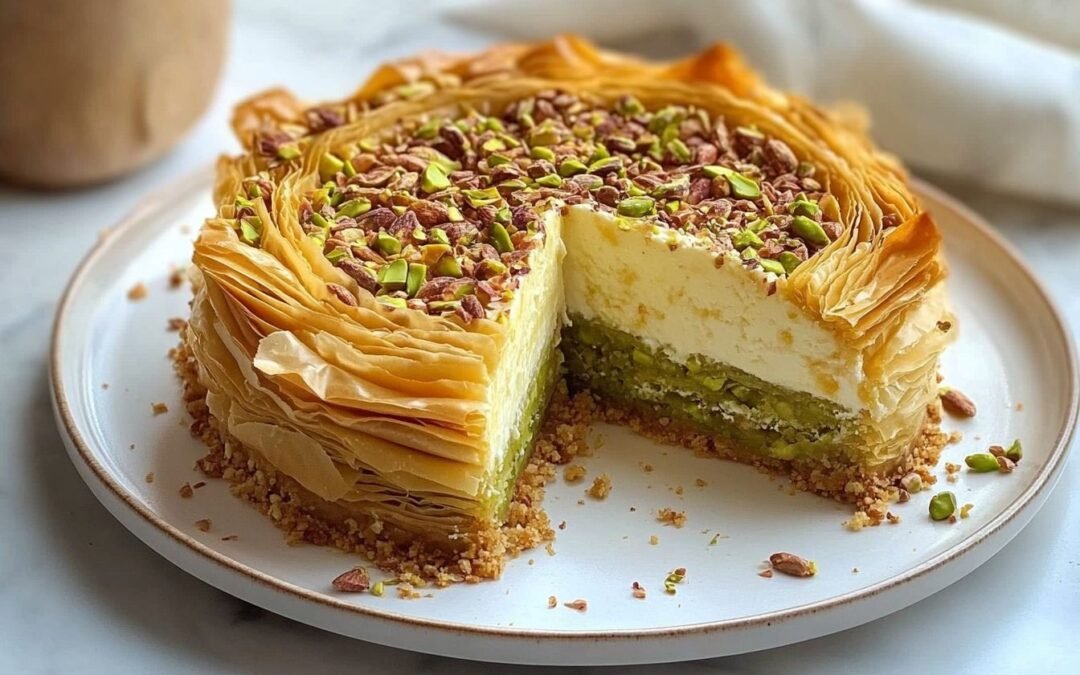I recently discovered a delicious Middle Eastern dessert called osmallieh, also known as kunafa pastry. This sweet treat is made from thin, shredded pastry dough that is layered with fresh Arabic cream kushta and fried until crispy and golden. The pastry is then drizzled with a sweet sugar syrup and topped with minced pistachios for added crunch.
To make osmallieh at home, you’ll need some key ingredients, including kunafa pastry, Arabic cream kushta, frying oil, lemon jam, and minced pistachios. For the sugar syrup, you’ll need sugar, water, orange blossom water, rose water, and lemon juice.
Whether you’re a fan of Middle Eastern cuisine or simply looking to try something new, osmallieh is a must-try dessert. With its crispy, creamy, and sweet flavors, it’s sure to become a new favorite in your dessert repertoire.
History of Osmalieh
As a dessert originating from the Middle East, osmalieh has a rich history that dates back centuries. In this section, I will briefly discuss the origins and regional variations of this sweet treat.
Origins
The exact origins are unknown, but it is believed to have been created in the city of Nablus during the Ottoman Empire. It is said that the dessert was first made by a famous pastry chef named As’ad Al-Sha’ar. The dessert became popular in the region and eventually spread to other parts of the Middle East.
Regional Variations
Osmalieh is popular in various parts of the world, with each region putting its own spin on the dessert. In Egypt, for example, Osmalieh is often served with cream and nuts. In Lebanon, it is sometimes made with cheese instead of the traditional pastry dough. However, in Turkey, it is often served with syrup made from honey and rosewater.
The basic ingredients and preparation method remain the same despite these regional variations. The dessert contains layers of thin pastry dough with a sweet filling, usually made of crushed pistachios, and then soaked in a sweet syrup.
Ingredients:
- 2 lbs of Osmallieh (Kunafa) pastry
- 1 lb of fresh Arabic cream kushta
- 5 cups of frying oil
- ¼ cup of lemon jam
- ½ cup of minced pistachio
For the sugar syrup:
- 2 ½ cups of sugar
- 1 ½ cups of water
- 1 teaspoon of orange blossom water
- 1 teaspoon of rose water
- 1 teaspoon of lemon juice
How to Make Osmalieh?
Preparing the sugar syrup:
- Combine sugar and water in a small saucepan over medium heat. Stir until the sugar dissolves and let it boil. Then add lemon juice and keep it on medium heat for 10 minutes until the syrup thickens. Finally, add orange blossom water and rose water, and transfer it to a large bowl.
Making the pastry:
- After dividing the pastry in half, lay the first part in a deep, 30cm-wide pan. Brush with oil and fry until it turns golden.
- Then, take it out, filter off the oil, and put it on a cardboard piece that has the same diameter.
- Repeat this process with the second part of the pastry.
- When the pastry’s done, place one piece on a plate. Add walnut or fresh Arabic cream (Kushta) on top and layer the second piece over it.
- Then, spread the syrup to cover all the parts and spread small hills of Kushta evenly on top. Finally, add some lemon jam and minced pistachio on top of each hill.
- To serve, I recommend enjoying Osmalieh hot or keeping it in the refrigerator for one day only. With these simple steps, you can create a delicious dessert that will leave your guests wanting more.
Serving and Presentation
As with many Middle Eastern dishes, presentation and serving are an important part of the Osmalieh experience. Here are some traditional and modern methods of serving this delectable dessert.
Traditional Serving Methods
Traditionally, osmalieh is served on a large platter, with the pastry arranged in a circular pattern. A generous amount of syrup is then poured over the pastry, giving it a sweet and sticky texture. Crushed pistachios are sprinkled on top, giving the dessert a crunchy texture and a pop of color.
Another traditional way of serving is to place it in individual bowls, with each serving consisting of a small portion of pastry, syrup, and pistachios. This method is perfect for those who prefer a smaller serving size.
Modern Twists
While the traditional methods of serving are still popular, modern twists have emerged in recent years. Some chefs have started to experiment with different flavors and textures, such as adding rosewater or cardamom to the syrup.
Another modern twist is to serve it in a cone-shaped pastry shell, similar to a waffle cone. The pastry is then filled with cream and topped with crushed pistachios and syrup. This method gives the dessert a unique and fun twist, perfect for those who love trying new things.
Variations of Osmalieh
Dietary Adaptations
For those with dietary restrictions, there are also variations of osmalieh that can be enjoyed. For example, some people make it with gluten-free semolina flour, while others use vegan cream instead of kushta to make it dairy-free. There are even versions made with honey instead of sugar for those who prefer a more natural sweetener.
No matter where you go, this is a beloved dessert that has been enjoyed for generations. Its versatility and adaptability make it a dessert that can be enjoyed by everyone, regardless of dietary restrictions or personal preferences.
Did you know? This can be a perfect dessert after having batata mahshi.
Get the recipe now (by clicking the image below):




